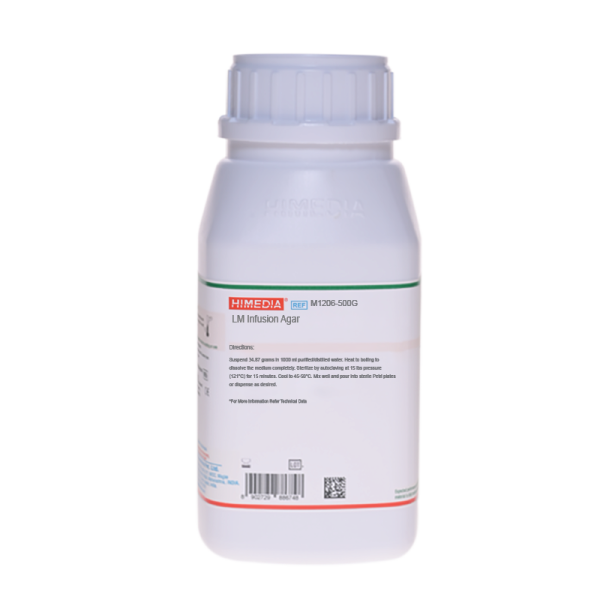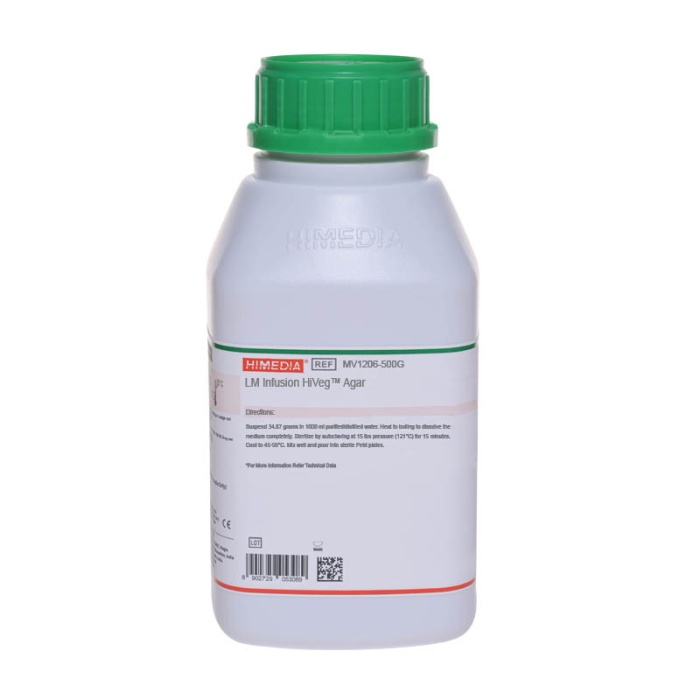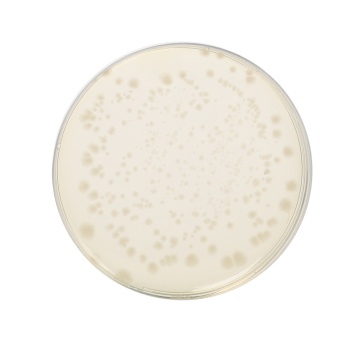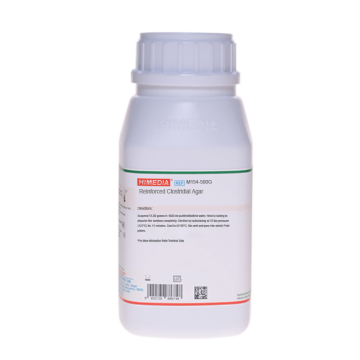 Your enquiry has been submitted
Your enquiry has been submitted
LM Infusion Agar (Liver Meat Infusion Agar)
Clostridium perfringens#CC293D
Intended Use
Recommended for the enumeration of sulphite reducing Clostridia and Clostridium perfringens in water and milk.
Composition
| Ingredients | Gms/Litre |
|---|---|
| HML infusion powder # | 20.000 |
| Dextrose (Glucose) | 0.750 |
| Starch | 0.750 |
| Sodium sulphite | 1.200 |
| Ferric ammonium citrate | 0.500 |
| Sodium carbonate | 0.670 |
| Agar | 11.000 |
Final pH (at 25°C): 7.6±0.2
**Formula adjusted, standardized to suit performance parameters
# Equivalent to Meat liver infusion powder
Directions
Suspend 34.87 grams in 1000 ml purified / distilled water. Heat to boiling to dissolve the medium completely. Sterilize by autoclaving at 15 lbs pressure (121°C) for 15 minutes. Cool to 45-50°C. Mix well and pour into sterile Petri plates or dispense as desired.
Principle And Interpretation
Anaerobic bacteria live in an oxygen-free environment. Some anaerobic bacteria actually die if oxygen is present, while others fail to grow and multiply (1).
Presence of HML infusion powder in the medium provides adequate degree of anaerobiosis besides provision of rich supply of nutrients, enabling even strict and fastidious anaerobes to grow well. Clostridium species reduce sulphite present in the medium to hydrogen sulphide (H2S), which is indicated by blackening due to the presence of iron salt. The agar medium is inoculated either by pour plate method or by surface spreading methods.
Type of specimen
Dairy samples; Water samples
Specimen Collection and Handling
For dairy samples, follow appropriate techniques for sample collection and processing as per guidelines (2). For water samples, follow appropriate techniques for sample collection, processing as per guidelines and local standards (3). After use, contaminated materials must be sterilized by autoclaving before discarding.
Warning and Precautions
Read the label before opening the container. Wear protective gloves/protective clothing/eye protection/face protection. Follow good microbiological lab practices while handling specimens and culture. Standard precautions as per established guidelines should be followed while handling specimens. Safety guidelines may be referred in individual safety data sheets.
Limitations
- Individual organisms differ in their growth requirement and may show variable growth patterns on the medium.
Performance and Evaluation
Performance of the medium is expected when used as per the direction on the label within the expiry period when stored at recommended temperature.
Quality Control
Appearance: Light yellow to light brown homogeneous free flowing powder
Gelling: Firm, comparable with 1.1% Agar gel
Colour and Clarity of prepared medium: Brown coloured opalascent gel with suspended particles forms in Petri plates.
Reaction: Reaction of 3.48% w/v aqueous solution at 25°C. pH: 7.6±0.2
pH Range: 7.40-7.80
Cultural Response
Cultural characteristics observed under anaerobic condition, after an incubation at 35-37°C for 18-48 hours.
| Organism | Inoculum (CFU) | Growth | Recovery | H2S |
|---|---|---|---|---|
| Clostridium perfringens ATCC 12924 | 50-100 | luxuriant | >=50% | positive |
| Clostridium tetani ATCC 10779 | 50-100 | luxuriant | >=50% | positive |
| Escherichia coli ATCC 25922 (00013*) | 50-100 | luxuriant | >=50% | negative |
| Proteus mirabilis ATCC 25933 | 50-100 | luxuriant | >=50% | negative or weakly positive |
| Clostridium botulinum ATCC 25763 | 50-100 | luxuriant | >=50% | positive |
| Bacteroides vulgatus ATCC 8482 | 50-100 | good-luxuriant | >=50% | negative |
Key: (*) Corresponding WDCM numbers.
Storage and Shelf Life
Store between 10-30°C in a tightly closed container and the prepared medium at 20-30°C. Use before expiry date on the label. On opening, product should be properly stored dry, after tightly capping the bottle in order to prevent lump formation due to the hygroscopic nature of the product. Improper storage of the product may lead to lump formation. Store in dry ventilated area protected from extremes of temperature and sources of ignition. Seal the container tightly after use. Product performance is best if used within stated expiry period.
Disposal
User must ensure safe disposal by autoclaving and/or incineration of used or unusable preparations of this product. Follow established laboratory procedures in disposing of infectious materials and material that comes into contact with sample must be decontaminated and disposed of in accordance with current laboratory techniques (4,5).
Reference
- Alcamo E. I., 2001, Fundamentals of Microbiology, 6th Ed., Jones and Bartlett Publishers.
- American Public Health Association, Standard Methods for the Examination of Dairy Products, 1978, 14th Ed., Washington D.C.
- Baird R.B., Eaton A.D., and Rice E.W., (Eds.), 2015, Standard Methods for the Examination of Water and Wastewater, 23rd ed., APHA, Washington, D.C.
- Isenberg, H.D. Clinical Microbiology Procedures Handbook 2nd Edition.
- Jorgensen, J.H., Pfaller, M.A., Carroll, K.C., Funke, G., Landry, M.L., Richter, S.S and Warnock., D.W. (2015) Manual of Clinical Microbiology, 11th Edition. Vol. 1.
| Product Name | LM Infusion Agar (Liver Meat Infusion Agar) |
|---|---|
| SKU | M1206 |
| Product Type | Regular |
| Physical Form | Powder |
| Origin | Animal |
| Packaging type | HDPE |
| References | 1. Alcamo E. I. , 2001, Fundamentals of Microbiology, 6th Ed., Jones and Bartlett Publishers |
| Customized Product Available | No |











